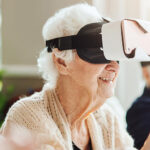Future of senior care technology discussed by experts

LONDON: Solutions such as smart homes, augmented and virtual reality, and wearables can help providers deliver care to a growing population of older adults, claim a panel of experts.
Significant demographic shifts headed in opposite directions are placing a major strain on the healthcare industry.
First, the population of the United States is getting older. A May 2021 report projects that by 2040, the U.S. will be home to nearly 81 million adults age 65 or older, up from 54 million in 2019. As the nation gets older, its need for healthcare services grows.
However, the number of healthcare professionals available to care for this aging population is shrinking. The American Health Care Association and National Center for Assisted Living found in September 2021 that 59 percent of nursing homes reported serious staffing shortages.
What can help healthcare organizations meet the growing need for care? Technology. Solutions such as Internet of Things-connected devices, augmented reality (AR), virtual reality (VR) and wearables can help healthcare providers monitor and treat patients more effectively while reducing the demands on clinicians.
“The global pandemic very much accelerated the fact that technology is a must-have on living campuses for older adults,” says Liz Cramer, chief post-acute care strategist with CDW. “The world is looking at ways to enhance workflows and make staff more mobile. This has accelerated the need for technology, the use of technology and the growth of technology budgets.”
Smart Technology Extends the Reach of Care Providers
Connected devices such as smart home technology for lighting, door locks, heating and air conditioning, as well as smart assistants that enable these systems to be voice-controlled, provide valuable benefits in both assisted and independent living communities.
“Advances in smart home technologies allow residents to age in place longer,” says Jessica Longly, a senior care strategist with CDW Healthcare. “Patients with congestive heart failure or chronic obstructive pulmonary disorder can use smart home tools to make living easier for them. These advances will take pressure off nursing staff, and the automation of rote tasks will enable them to spend more time with patients.”
As living communities for older adults adopt smart solutions in greater numbers, they may face challenges managing and securing them. Security tools that allow management of device fleets can ease the burden on IT teams.
AR and VR Bring Valuable Benefits to Older Adults
AR and VR solutions offer significant promise for independent and assisted living communities. “VR was emerging as an important technology before the pandemic,” Longly says. “It kind of took a back seat during the pandemic, but it’s coming back now.”
VR tools can help patients with physical fitness, therapy and rehabilitation and assist clinicians in assessing balance and fall risks. Care providers also have used VR to manage pain and calm patients with conditions such as Alzheimer’s disease.
Further, older adults can take advantage of VR to engage in experiences that otherwise might be unavailable to them, such as visiting a foreign country or seeing a Broadway show. Research suggests that regularly engaging in these virtual experiences can improve older adults’ feelings of relaxation and well-being.
Wearables and Fitness Trackers
Many assisted and independent living communities are finding that wearable devices such as smartwatches and fitness trackers can get older adults more involved in their own care while improving their health and safety. For example, devices such as the Samsung Galaxy Watch enable rigorous heart monitoring that can help both patients and clinicians closely monitor patients’ health.
Living communities that add predictive analytics capabilities to these solutions can help older adults keep an eye on chronic conditions and address small issues before they grow into significant health problems. Applications that run on wearable devices can enable providers to monitor patients’ blood pressure, detect atrial fibrillation and measure blood oxygen levels.
Wearables can also provide capabilities such as fall detection to help care providers respond more quickly to incidents.
“There is an opportunity for us to provide residents with wearables, so that we are staying connected with them, even when they’re outside of their apartments,” Longly says. “If we start to see that vitals are changing, we can send someone over to check on them if necessary.”
Ultimately, these technologies can help healthcare providers meet the growing demand for quality care.
- The future of senior care technology.







